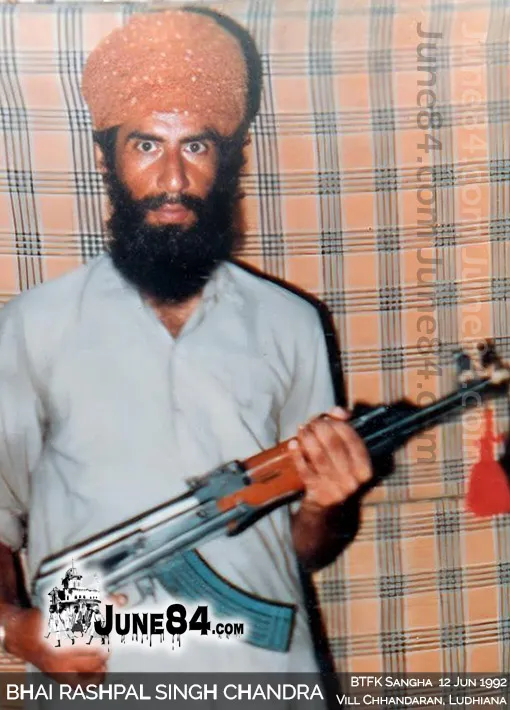Bhai Rashpal Singh Chandra remains one of the most courageous and inspiring figures in Sikh history. A bold and unwavering Kharku leader, he gave his life resisting state oppression during one of Punjab’s darkest chapters. His story is one of bravery, family sacrifice, and defiance against injustice. The legacy of Bhai Rashpal Singh Chandra continues to inspire generations who seek truth, dignity, and justice.
Early Life of Bhai Rashpal Singh Chandra
Born on 12 March 1965 in Chhandaran village, District Ludhiana, Rashpal Singh Chandra was raised in a deeply spiritual Sikh household. His father, Sardar Ranjit Singh, was a hardworking farmer who instilled strong moral values in him. After completing his higher secondary education, Rashpal Singh worked in agriculture to support his family.
However, the political climate of the 1980s—especially post-Operation Blue Star and the Sikh genocide of 1984—shaped his consciousness. Like many Sikh youths of his time, he was drawn toward the growing Sikh resistance movement aimed at defending Sikh identity and fighting state-sponsored oppression.
Role in the Kharku Movement
Rashpal Singh Chandra joined the Bhindranwale Tiger Force of Khalistan (BTFK), one of the most influential Sikh resistance groups. He became a leading member of the BTFK’s Sangha group. After the martyrdom of senior leader Bhai Paramjeet Singh Phulewal, Rashpal Singh rose to command the unit.
Under his leadership, the Sangha group operated actively in the Ludhiana region, carrying out missions and building grassroots support. He was known for his strict discipline, dedication to Sikh values, and strategic mindset. His name began to spread across Punjab as a daring figure who openly challenged state forces.
Family Life and Personal Sacrifices
In 1989, Bhai Rashpal Singh Chandra married Bibi Charanjit Kaur. The couple had one son, Amarippal Singh. However, their family life was constantly under threat due to Rashpal Singh’s involvement in the movement.
Tragedy struck in October 1991 when his father, Sardar Ranjit Singh, was abducted by police. He was kept in illegal custody, tortured for 20 days, and later killed. The loss did not break Rashpal Singh Chandra; instead, it strengthened his resolve.
In 1992, when Rashpal Singh was captured, police also arrested his wife and her mother. Both women were never seen again and are believed to have been killed in custody. The entire family became victims of state-sponsored violence, making their sacrifice total and heartbreaking.
Arrest and Martyrdom
On 12 June 1992, Bhai Rashpal Singh Chandra was traveling with close associate Jagdish Singh Disha near the Gill Canal bridge in Ludhiana. Police intercepted them by hitting their bicycle with a vehicle. Disha swallowed cyanide and died instantly, a common practice among freedom fighters to avoid capture.
Rashpal Singh Chandra, however, was captured alive.
He was taken into illegal custody and subjected to brutal torture. Reports indicate he was beaten with iron rods, burned with hot metal, and his legs were broken. His eyes were gouged out, his body mutilated, and his spirit tested to the limit.
But even under extreme torture, he did not break. When police chief KPS Gill demanded information on other Sikh fighters, Rashpal Singh spat in his face and boldly shouted, “Sat Sri Akal.” He chose death over betrayal and remained defiant until his final breath.
Cremation and Public Outrage
After days of silence, police finally handed over Rashpal Singh Chandra’s body to his family—under massive pressure from the Sikh community. His body bore over 300 injury marks, including crushed bones, broken limbs, burn marks, and missing nails. The torture was not hidden—it was imprinted on his corpse.
The Sikh Sangat gathered in large numbers to perform his cremation, hailing him as a true martyr. His funeral became a moment of collective mourning and defiance. The people of Punjab saw in him the living spirit of Sikh bravery and resistance.
Legacy of Bhai Rashpal Singh Chandra
Today, Bhai Rashpal Singh Chandra is remembered as a symbol of uncompromising courage. His leadership in the Sikh freedom movement, his moral clarity, and the ultimate sacrifice of his entire family make him one of the most respected martyrs of that era.
He did not die alone—his family followed the same path. His father, wife, and mother-in-law were all victims of the same repressive system. Their sacrifice is not just a historical footnote; it is a reminder of what it meant to live with dignity and die for one’s beliefs.
For many, Bhai Rashpal Singh Chandra’s life exemplifies the spirit of Chardi Kala—the eternal optimism of the Sikh soul—even in the face of brutality.
Final Thoughts
Bhai Rashpal Singh Chandra’s journey was not merely one of resistance—it was a story of honor. In a time when silence could ensure survival, he chose to speak. In a time when cooperation could bring relief, he chose defiance. His martyrdom echoes through the generations as a call to remember, to resist, and to rise with truth.
Let his legacy be a light in times of darkness. Let his name be remembered not as a victim, but as a warrior who chose dignity over fear, and justice over compromise.

